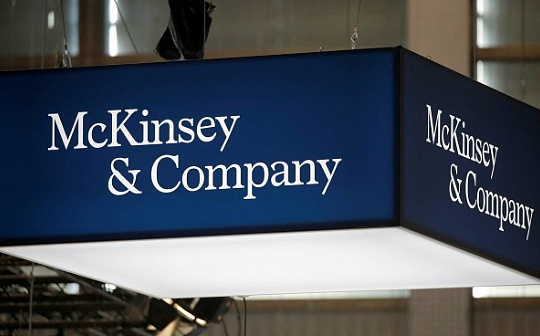
Source: Mckinsey; Compilation: Baishui, bitchain vision
Tokenized financial assets are shifting from pilot to large-scale deployment.Financial institutions with blockchain capabilities have not yet been widely used, but financial institutions with blockchain capabilities will have strategic advantages.
Tokenization is the process of creating a unique digital representation of assets on a blockchain network, and has reached a critical point after years of commitment and experimentation.These benefits, including programmability, composability, and enhanced transparency, can enable financial institutions to increase operational efficiency, increase liquidity and create new revenue opportunities through innovative use cases.These benefits are now being realized, with the first large-scale applications converting trillions of dollars of assets on-chain each month.However, many wrong starts and challenges have emerged so far.Further mainstreaming of these technologies in a robust, secure and compliant way will require cooperation and coordination among all stakeholders.As infrastructure players move from proof of concept to powerful scale solutions, there are still many opportunities and challenges that need to reimagine how the future of financial services will work.
If we are going to design the future of financial services, we can say that we will include many features of tokenized digital assets: 24/7 availability; instant global collateral liquidity; fair access; composability, thanks to a universal technology stack;And manage transparency.BlackRock Chairman and CEO Larry Fink highlighted the strategic future of the technology in January 2024, “We believe the next step will be tokenization of financial assets, which means everyStocks and every bond will be tokenized”, and more and more institutions are launching and expanding tokenized products, from tokenized bonds and funds to private equity and cash.
As technology matures and exhibits measurable economic benefits, asset digitalization now seems more inevitable.Despite the momentum, widespread adoption of tokenization is still far away.Modernizing existing infrastructure is challenging, especially in regulatory-heavy industries such as financial services.Overcoming inertia requires coordination of the entire value chain.In view of this,We expect a multi-wave wave of tokenization adoption: the first wave will be driven by use cases with proven ROI and existing scale.Next will be the use cases for asset classes that are currently smaller in markets, less profitable, or need to address more severe technical challenges.
According to our analysis,We expect the total tokenized market capitalization may reach around $2 trillion by 2030(Excluding cryptocurrencies like Bitcoin and stablecoins like Tether), which are mainly due to mutual funds, bonds and exchange-traded notes (ETNs), loans and securitizations and alternative funds.On optimism, that value could double to around $4 trillion, but as we approach the mid-century, we are less optimistic than previously published estimates.
In this article, we provide insights on how tokenization adoption works.We describe the current state of adoption (focusing primarily on a limited set of assets), as well as the benefits and considerations of broader tokenization.We then look at the current use cases that target meaningful market share and provide justification for the growth wave of different asset classes.For the remaining major financial asset classes, we examined the “cold start” problem and provided practical steps to overcome it.Finally, we consider the risks and benefits of pioneers and consider the “call to action” of all participants in the financial market infrastructure in the future.
Tokenization in the Inspur
The adoption rate and timing of tokenization vary by asset class due to expected returns, considerations, impact time, and risk preferences of market participants.We expect these factors to become the characteristics of possible emergence of activities and adoption waves.Asset classes with greater market value, greater friction in value chains, less mature traditional infrastructure or low liquidity are more likely to gain huge benefits from tokenization.For example, we believe that for asset classes with low technical complexity and regulatory considerations, tokenization is the highest.
Interest in investment in tokenization may be inversely proportional to the richness of fees earned by today’s less efficient processes, depending on whether the functionality is internal or outsourcing, and how concentrated the main players and their expenses are.Outsourcing often creates economies of scale, thus reducing the incentives for disruption.Influencing time—that is, how quickly investments related to tokenization can get returns—can enhance business cases and thus enhance interest in pursuing tokenization.
Specific asset classes can lay the foundation for subsequent asset classes adoption by introducing higher regulatory clarity, infrastructure maturity, interoperability and accelerated investment.Adoption will also vary by geographical location due to dynamic and changing macro environments (including market conditions, regulatory frameworks and buyer needs).Finally, compelling success or failure may drive or limit further adoption.
Asset Classes with Fastest Ways to Adopt
Tokenization is gradually advancing, and as network effects increase, tokenization is expected to accelerate.In view of its characteristics,By the end of the century, some asset classes may achieve meaningful adoption faster (defined as tokenized market capitalization of over $100 billion).We expect the most prominent leaders to include cash and deposits, bonds and ETNs, mutual funds and exchange-traded funds (ETFs), and loans and securitization.Adoption rates are already important for many of these projects, supported by the higher efficiency and value benefits brought by blockchain and higher technical and regulatory considerations.
We estimate thatBy 2030, the tokenized market capitalization of each asset class could reach about $2 trillion (excluding cryptocurrencies and stablecoins), driven primarily by the above assets(Figure 1).The range of pessimistic and optimistic scenarios is about $1 trillion to about $4 trillion, respectively.Our estimates do not include stablecoins, including tokenized deposits, wholesale stablecoins and central bank digital currencies (CBDCs) to avoid duplicate calculations, as these are often used as corresponding cash pillars in transaction settlements involving tokenized assets.
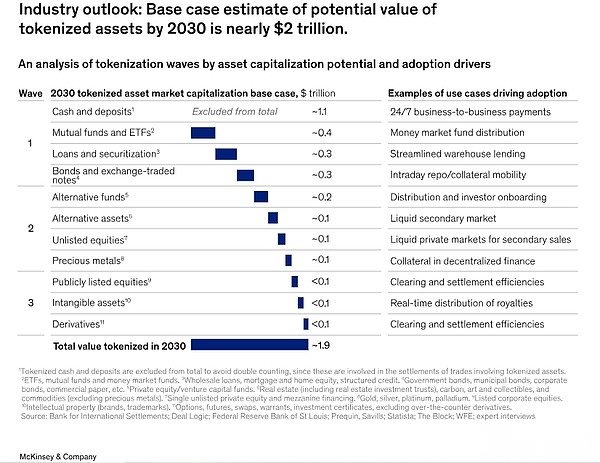
Mutual Funds
Tokenized money market funds have attracted more than $1 billion in managed assets, indicating the demand for investors with on-chain capital in a high interest rate environment.Investors can choose funds managed by veteran companies such as BlackRock, WisdomTree and Franklin Templeton, or funds managed by Web3 local companies such as Ondo Finance, Superstate and Maple Finance.Tokenized money market funds may see ongoing demand in a high interest rate environment, which may offset the role of stablecoins as on-chain store of value.Other types of mutual funds and ETFs can provide on-chain capital diversification for traditional financial instruments.
The transition to on-chain funds can significantly increase utility, including instant 24/7 settlement and the ability to use tokenized funds as payment tools.As the scope and scale of tokenized funds continue to expand, additional product-related and operational benefits will be realized.For example, a highly customized investment strategy will become possible through the composability of hundreds of tokenized assets.Storing data on a shared ledger reduces errors related to manual reconciliation and improves transparency, thus reducing operational and technical costs.While the overall demand for tokenized money market funds depends in part on the interest rate environment, it has now become an early germination of other funds’ attractiveness.
Loans and guarantees
Blockchain lending is in its infancy, but disruptors are beginning to succeed in this area: Figure Technologies is one of the largest non-bank home equity line of credit (HELOC) lenders in the United States, with billions of dollars in initiating.Web3 native companies such as Centrifuge and Maple Finance, as well as companies such as Figure, have already contributed to more than $10 billion in loan issuances involving blockchain.
We expect more adoption of loan tokenization, especially warehouse loans and on-chain loan securitization.Traditional loans are characterized by labor-intensive processes and high intermediary participation.Blockchain-backed loans offer an alternative with many benefits: Real-time on-chain data is kept in a unified master ledger as a single source of facts, promoting transparency and standardization throughout the loan life cycle.Supporting spending calculations and simplified reporting on smart contracts reduces the cost and labor required.Shorter settlement cycles and wider pools of funds can enable faster transaction processes and potentially reduce borrowers’ funding costs.
In the future, tokenizing borrowers’ financial metadata or monitoring their on-chain cash flows can achieve fully automated, fairer and more accurate underwriting.As more and more loans turn to private credit channels, incremental cost savings and speed are attractive benefits for borrowers.As overall digital asset adoption grows, demand for Web3 native is expected to increase.
Bonds and exchange-traded notes
Over the past 10 years, tokenized bonds with a total nominal value of more than $10 billion have been issued worldwide ($140 trillion in global outstanding nominal bonds).Recent notable issuers include Siemens, the City of Lugano and the World Bank, as well as other companies, government-related entities and international organizations.In addition, blockchain-based repos (repos) has been adopted, resulting in trillions of dollars in monthly transaction volumes in North America and creating value from the operational and capital performance of existing traffic.
Digital bond issuance may continue because once the scale is expanded, the potential returns are high and the current threshold is relatively low, partly due to stimulating the appetite for capital market development in some regions.For example, in Thailand and the Philippines, the issuance of tokenized bonds allows small investors to participate through segmentation. Although so far, the returns are mainly reflected in the issuance, the end-to-end tokenized bond life cycle can be achieved through dataClarity, automation, embedded compliance (e.g., transferability rules encoded at the token level) and simplified processes (e.g., asset services) to improve operational efficiency by at least 40%.In addition, lower costs, faster issuance or blocking can improve small sizes by enabling “timely” financing (i.e. optimizing borrowing costs by raising specific amounts at a specific time) and leveraging a global capital pool to expand the investor base, thereby improving small sizesFinancing by the issuer.
Focus on buying back
A repo agreement, or “repos”, is an example of tokenization adoption and its benefits that can be observed today.Broadridge Financial Solutions, Goldman Sachs and JPMorgan Chase are currently trading trillions of repurchases per month.Unlike some tokenization use cases, repos do not require tokenization within the value chain to achieve material benefits.
Financial institutions that tokenize repurchases mainly capture operational and capital performance.In terms of operations, supporting the execution of smart contracts can automate daily life cycle management (e.g. collateral valuation and margin recharge).It reduces errors and settlement failures and simplifies reporting; 24/7 Instant settlement and on-chain data also improve capital efficiency through intraday liquidity of short-term borrowings and enhanced collateral use.
Historically, most repos have a duration of 24 hours or more.Intraday liquidity can reduce counterparty risks, reduce borrowing costs, achieve short-term incremental borrowing inert cash, and reduce liquidity buffering.Real-time, 24/7, cross-jurisdictional collateral liquidity can provide higher yield, high-quality current assets and enable optimized flow of the collateral among market participants, thereby maximizing its availability.
The subsequent asset wave
The first wave of assets described above has provided some degree of independent avenues for adoption today and next two to three years.Conversely, tokenization of other asset classes is more likely to scale up only if previous asset classes have laid the foundation, or if there are catalysts to stimulate progress despite limited evidence of short-term benefits.
In the eyes of many market participants,One class of assets with huge potential tokenization is alternative funds, which may trigger growth in managed assets and simplify fund accounting.Smart contracts and interoperable networks can more effectively manage a full-price portfolio at scale by automated portfolio rebalancing.They can also provide new sources of capital for private assets.Split and secondary market liquidity may help private equity funds acquire new capital from retail small and high net worth individuals.In addition, transparent data and automation on the unified main ledger can improve the operational efficiency of middle and backend activities.Several existing companies, including Apollo and JPMorgan Chase, are experimenting to test what portfolio management might look like on blockchain.However, in order to fully realize the benefits of tokenization, underlying assets must also be tokenized, and regulatory considerations may limit the available assets.
For several other asset classes, adoption may be slower, either because expected returns are only incremental, or due to considerations such as meeting compliance obligations or lack of incentives for adoption of key market participants (Figure 2).These asset classes include publicly traded and unlisted stocks, real estate and precious metals.
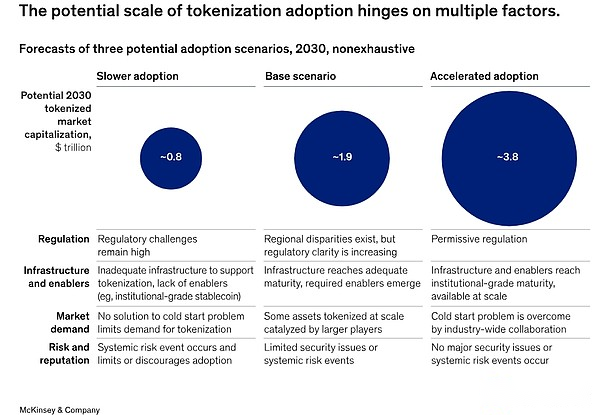
Overcome cold start problem
The cold start problem is a common challenge to adopt innovation, where products and their users need to grow at a healthy rate, but neither can succeed alone.In a world of tokenized financial assets, issuance is relatively easy and replicable, but only real scale can be achieved by realizing network effects: when users (usually investors on the demand side) capture real value, whether from cost savingsOr higher liquidity, or enhanced compliance.
In practice, while progress has been made in proof-of-concept experiments and the launch of a single fund,Token issuers and investors still face familiar cold start problems: limited liquidity hinders issuance due to insufficient trading volume to build a strong market; fears that losing market share may lead pioneers to support parallel issuances of traditional technologiesIncur additional costs; despite considerable benefits, incumbent companies may experience inertia due to disruption of established processes (and related costs).
One example is the tokenization of bonds.New tokenized bonds are announced almost every week.Although billions of dollars of tokenized bonds are currently in circulation, the benefits of relatively small compared to traditional issuances are still scarce.Here, overcoming the cold start problem requires building a use case where the digital representation of collateral can bring material benefits, including greater liquidity, faster settlement and more liquidity.Providing true, sustained long-term value requires coordination across multiple value chains and wide participation of participants in new digital asset classes.
Given the complexity of upgrading the underlying operating platform of the financial services industry, we believe that the minimum viable value chain (MVVC) (by asset class) is needed to scale tokenization solutions and overcome some of these challenges.To fully realize the benefits described in this article, financial and cooperative institutions must cooperate on a common or interoperable blockchain network.This interconnected infrastructure represents a new paradigm and raises regulatory concerns and some considerations (Figure 3).
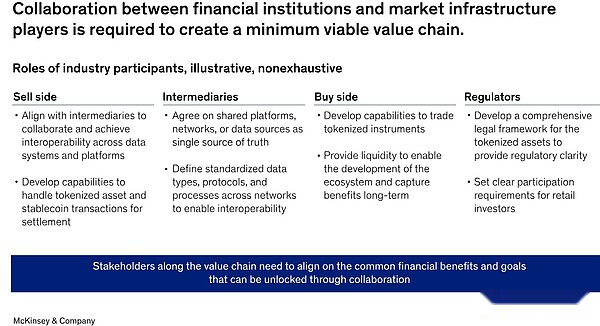
Work is currently underway to build a universal or interoperable blockchain for institutional financial services, including Project Guardian of the Monetary Authority and a regulated settlement network.In the first quarter of 2024, the Canton Network pilot brought together 15 asset management companies, 13 banks, as well as multiple custodians, exchanges and a financial infrastructure provider to perform simulated transactions.The pilot validates that traditional siloed financial systems can leverage publicly licensed blockchains while maintaining privacy controls.
While both public and private blockchains have successful examples, it is not clear which one will carry the most transaction volume.Currently, most federal regulators in the United States do not encourage the use of public blockchains for tokenization.But globally, many institutions choose Ethereum as a public network because of its liquidity and composability.With the continuous construction and testing of unified ledgers, the debate between public and private networks is far from over.
The way forward
Comparing the current status of financial asset tokenization with the emergence of other paradigm shift technologies shows that we are in the early stages of adoption.Consumer technologies (such as the Internet, smartphones, and social media) and financial innovations (such as credit cards and ETFs) usually show the fastest growth (annual growth rate of more than 100%) in the first five years after their birth.We then found that growth slowed to around 50% each year, eventually achieving a milder CAGR of 10% to 15% over a decade later.Although experiments began as early as 2017, large-scale issuance of modern monetized assets has not yet emerged in recent years.Our estimate of market capitalization for 2030 is assuming that the average compound annual growth rate of each asset class is 75%.Among them, the first wave of assets is on the leading path.
While tokenization can reasonably be expected to stimulate this decades-long transformation in the financial industry, it may have special benefits for pioneers who can “keep up to the trend.”Pioneers can capture a huge market share (especially in markets that benefit from economies of scale), improve their efficiency, develop formats and standard agendas, and benefit from embracing the reputation aura of emerging innovations.Early promoters of tokenized cash payments and on-chain repos have proved this.
But more institutions are in a “waiting and watching” state, looking forward to clearer market signals.Our argument is,Tokenization is at a critical point, which suggests that this pattern may be too slow once we see some important signs, including the following:
-
Infrastructure:Blockchain technology has the ability to support trillions of transaction volumes;
-
integrated:Blockchains with different applications demonstrate seamless interconnectivity;
-
Promoting factors:Wide use of tokenized cash (such as CBDC, stablecoins, tokenized deposits) for instant transaction settlement;
-
need:The willingness of buyer participants to invest in capital products on the chain on a large scale;
-
Supervision:Provide certainty and support actions across jurisdictions to equitable, transparent and efficient financial systems, and clarify data access and security.
While we have not seen all of these markers appear yet, we expect that adoption (widely used) will follow the tokenization wave described earlier.This adoption will be led by financial institutions and market infrastructure players who come together to establish a leading position in value acquisition.We call these collaborations the minimum viable value chain.Examples of MVVC include the blockchain-based repo ecosystem operated by Broadridge, and Onyx, which JPMorgan Chase works with Goldman Sachs and Bank of New York Mellon.
In the next few years, we expect more MVVC to gain value from other use cases, such as instant enterprise-to-business payments through tokenized cash; asset managers dynamically “smart” on-chain fundsManagement; or efficient life cycle management of government and corporate bonds.These MVVCs may be supported by online platforms created by existing enterprises and fintech disruptors.
For pioneers, risks and returns coexist: the early investment and risks of investing in new technologies may be very high.Not only are pioneers attracting attention, but the development of infrastructure and running parallel processes on legacy platforms are time- and resource-intensive.Furthermore, in many jurisdictions, regulatory and legal certainty for participation in any form of digital assets is lacking, and key enablers have not yet been provided, such as the widespread use of wholesale tokenized cash and settled deposits.
The history of blockchain applications is full of such challenges.This history may prevent established businesses that are as usual on traditional platforms as they do, and they may feel safer.But this strategy can bring risks, including significant losses in market share.As today’s high interest rate environment has created clear use cases for some tokenized products such as repo agreements, it is possible that market conditions can quickly affect demand.With the development of waves of adoption, such as the clarity of regulation or the maturity of infrastructure, trillions of dollars in value can be shifted on-chain, creating a considerable pool of value for pioneers and disruptors (Figure 4).
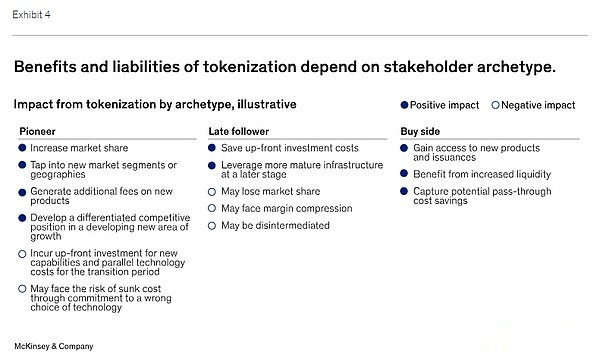
In the short term, institutions including banks, asset managers and market infrastructure players should evaluate their product suite and determine which assets will best benefit from transitioning to tokenized products.We recommend questioning whether tokenization can accelerate strategic priorities such as entering new markets, launching new products and/or attracting new customers.Are there potential use cases that can create value in the short term?What internal capabilities or partnerships are needed to capitalize on the opportunities created by market transformation?
By combining the pain points of (buyer and seller) with buyer and market conditions, stakeholders can evaluate where tokenization poses the greatest risk to their market share.But to realize all benefits, it is necessary to convene counterparties to cooperate to create a minimally feasible value chain.Addressing these growing annoyances now can help existing participants avoid catching up when demand inevitably surges.








